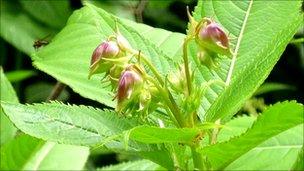Project to stop invasive plants in Wiltshire launched
- Published

Himalayan balsam is an annual plant that grows into bank side thickets, crowding out native wildlife
A new project in Wiltshire aims to stem the spread of non-native invasive plants throughout the River Avon and its tributaries.
Source to Sea is a joint project between Wiltshire Wildlife Trust (WWT), Hampshire and Isle of Wight Wildlife Trust and Dorset Wildlife Trust.
The initiative aims to eradicate plants such as Himalayan balsam, Japanese knotweed and giant hogweed.
The WWT said the plants threatened to overwhelm rivers, streams and wildlife.
The project, which has received substantial backing from the Environment Agency, will see contributors and volunteers survey river catchments in the areas affected and remove the plants.
An integrated approach to the problem is being co-ordinated across the three counties because the River Avon rises in the Vale of Pewsey in Wiltshire and passes through Hampshire at the edge of the New Forest before flowing into the sea at Christchurch in Dorset.
'Magical waterways'
Sam Stork, Source to Sea project manager at WWT, said: "The Salisbury Avon and tributaries such as the Nadder and Wylye are magical waterways recognised for their magnificent wildlife by being designated as Sites of Special Scientific Interest and Special Area of Conservation.
"Non-native invasive plants could threaten the survival of their water voles and otters, Atlantic salmon, brown trout and lamprey if we stand by and do nothing while these plants steadily suffocate the banks.
"For the project to succeed we will need lots of volunteers to help us pull up the balsam, and we will need the help and support of riverside landowners to either remove the plants or allow access for our volunteers to remove them."
Wiltshire landowners looking for advice or people willing to help carry out surveys or practical work over the summer are asked to contact the WWT.
- Published4 May 2012
- Published30 August 2011